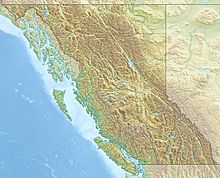Battle Mountain (British Columbia) facts for kids
Quick facts for kids Battle Mountain |
|
|---|---|

Battle Mountain seen from Fight Lake
|
|
| Highest point | |
| Elevation | 2,369 m (7,772 ft) |
| Parent peak | Trophy Mountain (2577 m) |
| Listing | Mountains of British Columbia |
| Geography | |
| Parent range | Shuswap Highland |
| Topo map | 82M/13 or PS-WG3 (south half) |
| Geology | |
| Mountain type | Pyramidal peak |
| Climbing | |
| Easiest route | Via Fight Lake and Fiftytwo Ridge |
Battle Mountain is a mountain located in east-central British Columbia, Canada. It's found in the southeastern part of Wells Gray Provincial Park. The Clearwater River flows to its west. This mountain is part of the Shuswap Highland range. There are actually three main peaks in this group, with heights from 2,306 meters (7,566 feet) to 2,369 meters (7,772 feet).
Battle Mountain is a popular spot for summer visitors. It's especially famous for its colorful alpine meadows, which are fields of wildflowers high up in the mountains. Getting to Battle Mountain involves a mix of driving and hiking. The trail is longer and tougher than the one to nearby Trophy Mountain. Because of this, fewer people visit Battle Mountain and its Caribou Meadows. You can hike to the meadows in one day. But if you want to reach Fiftytwo Ridge and the very top of Battle Mountain, you should plan for a two-day trip and bring overnight camping gear.
Contents
Getting to Battle Mountain
To reach Battle Mountain, you'll first turn east onto Battle Mountain Road. This road is off Clearwater Valley Road, which is also called Wells Gray Park Road. The turn is about 26.6 kilometers (16.5 miles) north of the Yellowhead Highway. The first 2.4 kilometers (1.5 miles) of the gravel road are fine for all cars. After that, the road gets very steep and rough. You'll need a vehicle with high ground clearance for the next 5 kilometers (3.1 miles) to reach the parking lot.
The Hiking Trail
A well-used hiking trail starts from the parking lot.
- The first part of the trail is the steepest. It climbs 248 meters (814 feet) over 2.1 kilometers (1.3 miles). This section goes up the canyon of Philip Creek to a hanging valley where Philip Lake is located.
- After that, the trail becomes easier. It goes up another 170 meters (558 feet) to the start of the Caribou Meadows.
- The trail then winds through these beautiful meadows. It follows the west shore of Fight Lake.
- Finally, it climbs to the top of Fiftytwo Ridge. Beyond this point, it's more of a hiking route through meadows and rocky areas. You'll first go down into Bull Valley, then climb onto Battle Mountain itself.
The best time to hike on Battle Mountain is from late June through September.
Why the Names?
Many places around Battle Mountain have interesting names. Here's how some of them got their names:
Battle Mountain and Fight Lake
The names "Battle Mountain," "Battle Creek," and "Fight Lake" come from an old story. It's about a legendary battle that happened around 1875. This fight was between two groups of Indigenous people: the Chilcotin and the Shuswap bands.
In the mid-1800s, large herds of caribou (a type of deer) would travel through the Clearwater Valley each spring. The Chilcotin people hunted along most of this migration route. However, the Battle Mountain area was hunted by the Canim Lake band and the Shuswap band from Chu Chua.
Near some small lakes in Indian Valley, the Chilcotins built special traps. These were long fences made of wire and stone. They led to a narrow opening on the lakeshore. Caribou were chased through these V-shaped traps into the water. Then, hunters would spear them as they swam to shore. The battle likely happened near these traps. It was probably a disagreement over the caribou hunting grounds, as the number of animals started to decrease around that time.
Fiftytwo Ridge
This ridge was named because a biological study took place there in 1952. The study was done by Pat Martin and Ralph Ritcey.
Philip Creek and Mount Philip
- Philip Creek: This creek is named after William and Ella Philip. They were landowners in the Clearwater Valley.
- Mount Philip: Even though it's near Philip Creek, this mountain was named for Mr. C. Philips. He was an assistant on a land survey of the Clearwater Valley and Murtle Plateau in 1914.
Stevens Lakes
This group of six lakes is east of Battle Mountain. They are named after Whitney W. "Pat" Stevens. He worked for the British Columbia Forest Service. In 1921, when he was 22, he surveyed the forests in the Clearwater Valley. He spent most of his life working in forestry. He passed away in 1960.


